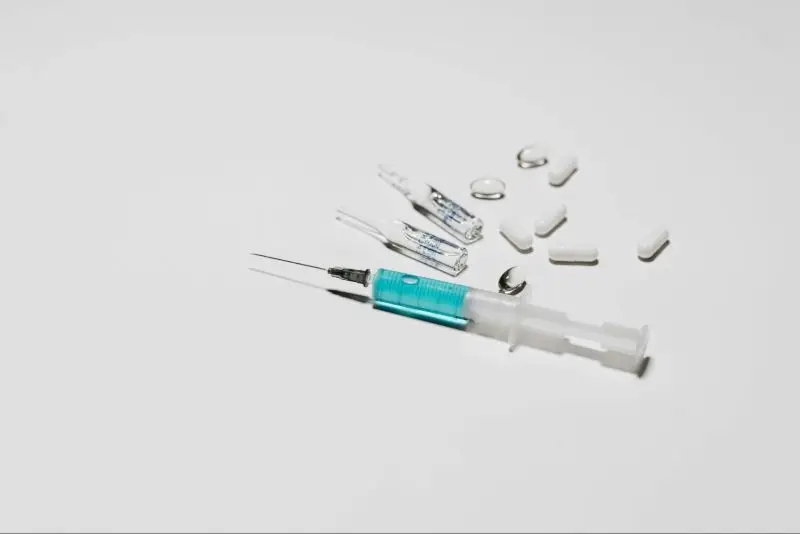Fentanyl myths—such as the false belief that accidentally touching fentanyl can be deadly—add confusion to an already complex issue of fentanyl abuse and overdose. While most people are aware that fentanyl is an exceptionally potent drug, many are misinformed about its true risks, dangers, and prevalence, which may create challenges in addressing the U.S. opioid epidemic.
This article will cover the most common fentanyl myths and facts to help you better understand how this synthetic opioid works and what the real dangers associated with it are.
What Is Fentanyl, and Why Is It So Dangerous?

Fentanyl is a synthetic opioid used to control severe pain that cannot be managed with non-opioid painkillers. It is also sometimes used for anesthesia. It is available in:
- Injection (Sublimaze®)
- Buccal tablets (Fentora®)
- Sublingual tablets (Abstral®)
- Transdermal patches (Duragesic®)
- Oral transmucosal lozenges (Actiq®)
Like all opioids, fentanyl attaches to opioid receptors in the central nervous system (CNS), which prevents pain signals from reaching the brain. It also rapidly triggers a dopamine rush, leading to intense euphoria and deep relaxation.
Although fentanyl is highly effective in alleviating pain, its extraordinary potency also enhances the potential for fentanyl abuse, dependence, addiction, and overdose.
Fentanyl Usage in the US
Let’s take a look at some recent fentanyl statistics that illustrate the magnitude of fentanyl use, abuse, and overdoses in the United States:
- Nearly 92% of all opioid overdose deaths in 2023 involved synthetic opioids, primarily fentanyl.
- In 2023, close to 29% of Americans using fentanyl misused it.
- 42% of counterfeit pills tested by the DEA contained a lethal dose of fentanyl.
- Between 2012 and 2022, fentanyl overdose rates in the United States increased by almost 2,710%, from 2,628 to 73,838 deaths.
- There were nearly 123,000 fentanyl-related emergency department visits in 2021 alone.
10 Common Myths About Fentanyl
Without further ado, let’s discuss some of the most common fentanyl myths:
#1. Touching fentanyl can be deadly
The belief that touching fentanyl can be deadly is among the most widespread myths about fentanyl. In truth, the likelihood of overdosing on fentanyl through accidental skin contact is extremely low, as fentanyl is poorly absorbed through the skin.
That said, children should be carefully supervised for accidental fentanyl exposures, as they tend to put objects and hands in their mouths.
If you touch a surface or an item contaminated with fentanyl, thoroughly wash your hands with soap and water. Make sure to avoid contact with your nose, eyes, and mouth. Do not use alcohol-based products, such as hand sanitizers, as this may increase skin absorption.
#2. Fentanyl is a street drug
While fentanyl is a common street drug, it was originally developed as an intravenous anesthetic and has approved medical uses. Specifically, it is approved as an anesthetic and an analgesic; it is most often prescribed for cancer, post-surgery, and other severe pain.
Unlike heroin, fentanyl is not an illicit opioid. It is treated as a Schedule II controlled substance due to the high potential for abuse and opioid addiction, meaning you can only legally obtain it by prescription.
Nonetheless, it has become a popular street drug due to its potency, low cost, and ease of manufacture, as well as the catalyst behind the third wave of the U.S. opioid epidemic.
#3. Fentanyl addiction is not treatable
Contrary to popular belief, fentanyl addiction is a treatable condition rather than a chronic, incurable disease. This is one of the most harmful myths about fentanyl, as it stigmatizes addiction and makes people addicted to fentanyl or other opioids less likely to seek and receive help.
Luckily, fentanyl addiction can be treated by seeking opioid addiction treatment that addresses the root cause of the issue, which is the chemical imbalance that occurs in the nervous system due to repeated fentanyl exposure. With the proper treatment, you can return to a sober and healthy life, even if you’ve been battling fentanyl addiction for months, years, or decades.
#4. Prescription fentanyl is less dangerous than street fentanyl
Although most fentanyl-related deaths indeed involve street fentanyl—or illegally made fentanyl (IMF)—prescription opioids are no less dangerous than illicit ones, and fentanyl is no exception. What does make prescription fentanyl slightly safer than street fentanyl, however, is that its purity and dosage are strictly controlled.
Prescription fentanyl can also lead to opioid abuse, dependence, addiction, and overdose. Even when taken under medical supervision, it can still be misused. Given how potent it is, it can lead to serious health risks, including overdose, even in tiny amounts.
For this reason, it is vital to take fentanyl precisely as prescribed and carefully monitor your opioid intake. If you accidentally miss a dose, do not take a double dose to reduce the risk of respiratory depression, overdose, and other adverse—and potentially deadly—effects.
#5. Fentanyl is the most potent opioid
Fentanyl is among the most potent opioids, but it is no longer the most potent. Recently, other, far more powerful synthetic opioids have made their way onto the streets, including isotonitazene, etonitazene, and other nitazenes.
For comparison, fentanyl is around 100 times more potent than morphine. Meanwhile, most nitazenes are 10–50 times more potent than fentanyl and upwards of 800 times more powerful than morphine.
Nonetheless, fentanyl remains the most potent opioid approved for medical use.
#6. All counterfeit prescription drugs are laced with fentanyl
Not all counterfeit prescription drugs are laced with fentanyl, but it doesn’t make them any safer. On the contrary, more often than not, illicit drugs are often substituted with fentanyl rather than laced with it.
In other words, manufacturers often press fentanyl into tablets resembling other prescription drugs, yet these tablets only contain fentanyl. Similarly, they may sell fentanyl powder and claim it’s something else. Most commonly, this happens with cocaine, illicit oxycodone, and counterfeit Xanax pills.
#7. Secondhand fentanyl smoke will cause an overdose
Secondhand fentanyl smoke, i.e., the smoke exhaled by someone smoking fentanyl or that coming off burning fentanyl products, is not likely to cause an overdose.
When smoked, fentanyl quickly enters the lungs, and most of it remains in the system. While tiny traces of fentanyl may be breathed out or released when fentanyl powder or pills are burned, these tend to disperse very quickly in the air.
Nonetheless, inhaling any type of secondhand smoke—be it tobacco, marijuana, or fentanyl—isn’t good for you. Therefore, it’s in your best interest to avoid public places that could expose you to secondhand smoke.
#8. Fentanyl dependence and fentanyl addiction are synonymous
The terms “fentanyl dependence” and “fentanyl addiction” are often used synonymously, but they describe two distinct conditions.
Fentanyl dependence refers to the physical dependence that develops as a result of prolonged drug use, meaning anyone who takes fentanyl for an extended time risks becoming dependent. It is characterized by two symptoms: tolerance and fentanyl withdrawal symptoms that occur upon drug discontinuation.
If left untreated, physical dependence can develop into a fentanyl addiction, which is predominantly psychological; those addicted cannot stop taking it, even when it harms their relationships, careers, or health. Some symptoms of fentanyl addiction include hiding or lying about drug use, becoming isolated, and being preoccupied with obtaining and using fentanyl.
#9. Contact with a fentanyl overdose victim is dangerous
One of the most harmful fentanyl overdose myths is that contact with someone overdosing on fentanyl is dangerous or even life-threatening. This simply isn’t true, as fentanyl can only be dangerous when ingested (i.e., snorted, injected, or swallowed).
Moving the victim, applying first aid, or performing CPR will not put you at risk; it will only increase the chances of survival. Therefore, you should not be scared of assisting someone during an overdose.
#10. Fentanyl overdoses are always fatal
Though often fatal, fentanyl overdoses can be reversed. Prompt medical intervention is critical to preventing death, as fentanyl overdoses can only be reversed by administering naloxone (Narcan®), an opioid antagonist medication that blocks the effects of opioids. For this reason, you should call 911 as soon as you notice someone overdosing on fentanyl.
Now that we’ve covered the most common fentanyl myths, let’s find out how to recognize a fentanyl overdose.
Fentanyl Overdose Signs and Symptoms

Fentanyl overdose signs and symptoms are technically the same as those of any other opioid overdose, as all opioids have identical effects on the brain.
However, fentanyl may cause respiratory depression and overdose at much lower doses than other opioids due to its potency. Mixing fentanyl with other substances (e.g., speedballing) increases the risk of an overdose even more.
The tell-tale signs of fentanyl overdose include:
- Vomiting
- Limp limbs
- Pinpoint pupils
- Slurred speech
- Severe confusion
- Skin discoloration
- Unresponsiveness
- Cold and clammy skin
- Loss of consciousness
- Difficulty staying awake
- Choking or gurgling sounds
- Slowed and shallow breathing
- Blue- or purple-tinted lips and fingernails
Fentanyl overdose symptoms can often look similar to a very intense high. In some cases, such as when buying drugs illicitly, people may not even know they are overdosing on fentanyl.
When it comes to fentanyl overdose, time is of the essence—without timely medical help, it can be fatal or have lifelong consequences, such as brain damage.
If you suspect that you or someone else is suffering from a fentanyl overdose, call 911 immediately and follow the operator’s instructions. Try to keep the person awake until the paramedics arrive and lay them on their side to prevent choking.
Conquer Fentanyl Dependence Within Days With ANR Treatment
Accelerated Neuro-Regulation (ANR) is a revolutionary opioid dependence treatment that can put an end to fentanyl dependence within a matter of days. Most ANR patients spend just 36 hours on average in the hospital.

Developed by Dr. Andre Waismann, ANR stands out as the first and only treatment that addresses the neurobiological causes of opioid dependence by re-regulating the endorphin-receptor system. Because ANR reverses the damage prolonged opioid exposure causes to the brain, it eliminates the risk of relapse together with opioid withdrawal symptoms.
What’s more, ANR is very safe, even for those with co-occurring medical issues like heart disease. The treatment is tailored to each patient individually and performed in an ICU setting of accredited hospitals with state-of-the-art equipment.
Furthermore, the ANR team includes anesthesiologists, critical care physicians, and other highly experienced board-certified healthcare professionals, so you can rest assured you’ll be in good hands throughout the treatment.
For more information, contact us today for a free, 100% confidential consultation. We’ll gladly answer your questions and ease any concerns you may have.
Key Takeaways
We hope this article helped you learn more about fentanyl and clear up any misconceptions you might’ve had. Most fentanyl myths are rooted in fear, and it’s not without reason—fentanyl is, indeed, a deadly drug.
However, exaggerating its dangers can cause irreversible damage; some people may even be scared of helping those overdosing on fentanyl out of fear for their safety. If there’s one thing you should never forget, though, it’s that when someone is overdosing on fentanyl, you could be their only lifeline; helping them won’t hurt you in any way.
Let’s summarize what we’ve discussed today:
- Fentanyl is an exceptionally potent opioid analgesic and anesthetic that can lead to abuse, dependence, addiction, and overdose.
- Some of the most common fentanyl myths include the belief that merely touching fentanyl can cause an overdose and that fentanyl addiction is an untreatable condition.
- Clear signs of a potentially fatal fentanyl overdose include discolored skin and lips, loss of consciousness, slowed breathing, and pinpoint pupils.
- ANR can help you break the chains of fentanyl dependence swiftly, safely, and effectively by re-regulating your endorphin-receptor system.



